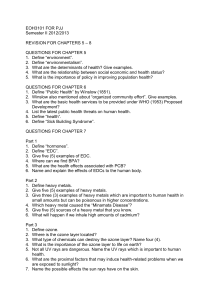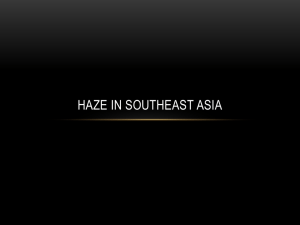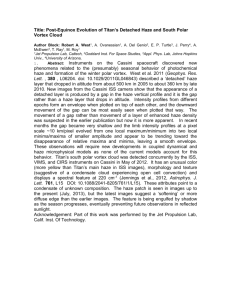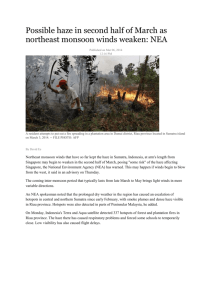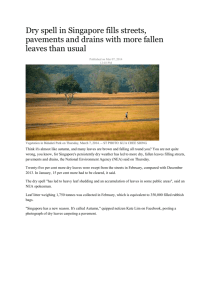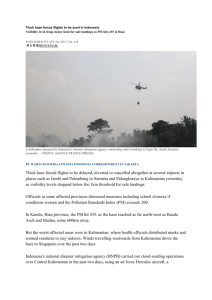Others - Singapore A Level Geography
advertisement
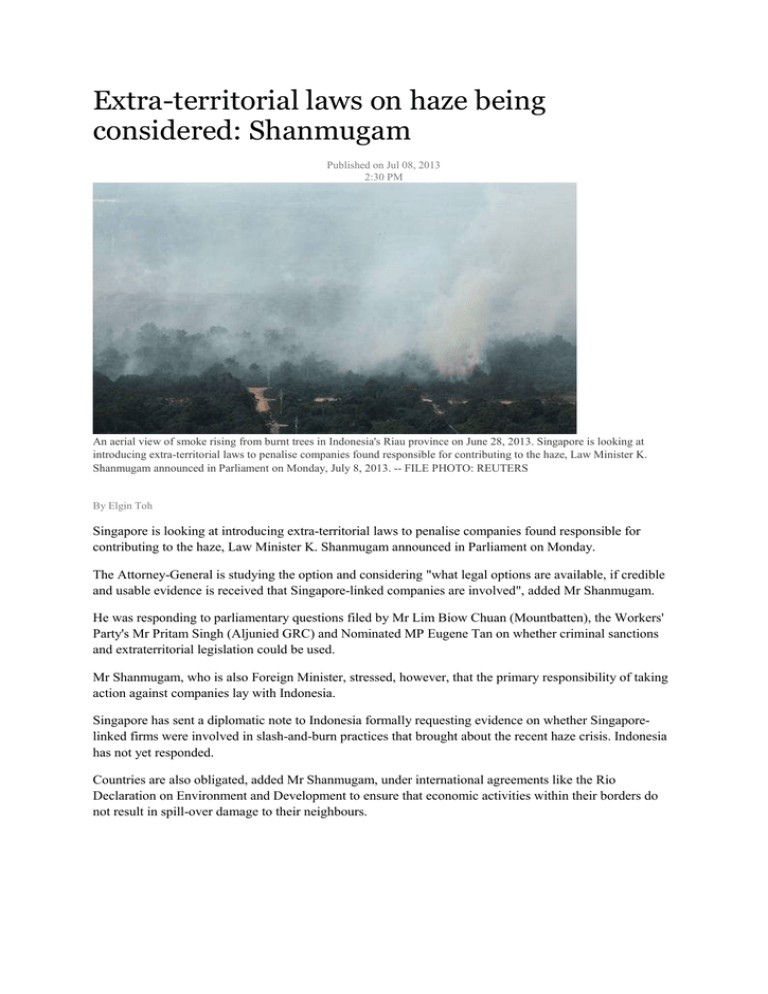
Extra-territorial laws on haze being considered: Shanmugam Published on Jul 08, 2013 2:30 PM An aerial view of smoke rising from burnt trees in Indonesia's Riau province on June 28, 2013. Singapore is looking at introducing extra-territorial laws to penalise companies found responsible for contributing to the haze, Law Minister K. Shanmugam announced in Parliament on Monday, July 8, 2013. -- FILE PHOTO: REUTERS By Elgin Toh Singapore is looking at introducing extra-territorial laws to penalise companies found responsible for contributing to the haze, Law Minister K. Shanmugam announced in Parliament on Monday. The Attorney-General is studying the option and considering "what legal options are available, if credible and usable evidence is received that Singapore-linked companies are involved", added Mr Shanmugam. He was responding to parliamentary questions filed by Mr Lim Biow Chuan (Mountbatten), the Workers' Party's Mr Pritam Singh (Aljunied GRC) and Nominated MP Eugene Tan on whether criminal sanctions and extraterritorial legislation could be used. Mr Shanmugam, who is also Foreign Minister, stressed, however, that the primary responsibility of taking action against companies lay with Indonesia. Singapore has sent a diplomatic note to Indonesia formally requesting evidence on whether Singaporelinked firms were involved in slash-and-burn practices that brought about the recent haze crisis. Indonesia has not yet responded. Countries are also obligated, added Mr Shanmugam, under international agreements like the Rio Declaration on Environment and Development to ensure that economic activities within their borders do not result in spill-over damage to their neighbours. Singapore's haze task force met before the crisis struck Published on Jul 08, 2013 3:21 PM The Singapore skyline shrouded in haze at 6.30pm on June 19, 2013. Singapore's inter-agency haze task force actually met on May 29, before the haze occurred, to go over what might happen, revealed Dr Ng Eng Hen in Parliament on Monday, July 8, 2013. -- ST FILE PHOTO: JAMIE KOH By Grace Chua Singapore's inter-agency haze task force actually met on May 29, before the haze occurred, to go over what might happen, revealed Dr Ng Eng Hen in Parliament on Monday. The 23-agency team was created in 1994 and has met each year to prepare for the annual dry season. It reports to a crisis management group comprising relevant ministries. Dr Ng chairs an inter-ministerial haze committee set up in June to oversee national efforts against the crisis, and was responding to MPs' questions on Singapore's national action plans on the smoke menace. During this year's haze episode, the committee focused on protecting public health and safety, working with Indonesia to curb the burning, and maintaining social and economic resilience, he said. When there was panic-buying of N95 masks and bottlenecks in getting masks to retailers, "the first task was to restore calm and protect the vulnerable", said Dr Ng, giving out free masks to needy households and distributing three million more masks to retailers. But he admitted community guidance could be improved with more timely information while recognising that "not everyone wants or needs the same amount of information". On the responses to crises, he assured the public that "our basic structure is comprehensive and sound, but we should always learn from every episode". Singapore needs "two essential elements" to withstand threats, he added: trust between leaders and people, and care for each other. "The day we lose that trust, the day we stop caring...any crisis will be too big for us." N95 masks were meant for health workers in an epidemic That's why it took time to get stocks out to public during the haze episode Published on Jul 09, 2013 7:22 AM Singapore's stockpile of nine million N95 masks was not readily available in the shops last month because they were meant for an infectious-disease epidemic, said Dr Ng Eng Hen in Parliament. -- ST FILE PHOTO: KUA CHEE SIONG By Grace Chua Singapore's stockpile of nine million N95 masks was not readily available in the shops last month because they were meant for an infectious-disease epidemic, said Dr Ng Eng Hen in Parliament. The masks, which filter out small particles, were not originally for the public. They were kept by the Government to prevent the spread of disease to health-care workers, he explained. "That stockpile is quite important in case, touch wood, Middle East Respiratory Syndrome (a virus similar to Sars) viruses come here," he said yesterday. "So the way they were stored... the assumption was for a particular rate of use." He was responding to MPs' concerns that there were delays and bottlenecks getting N95 masks to the public during last month's haze episode - a major concern which saw queries from six legislators. Dr Ng, who is Defence Minister and chairman of an inter-ministerial haze committee, explained that retailers' distribution channels could not cope with the spike in demand. "There are few systems where one day to the next, your demand is one day, 5,000; the next, one million," he said. But despite the crunch, the Government decided to provide for the needy, he added, distributing about a million masks to 200,000 households. "We didn't know how long the haze would last," he said in response to a question from Mr Baey Yam Keng (Tampines GRC). "There wasn't really a shortage, but out of concern that the poor and vulnerable would not be able to get (masks), we met and decided that ministries would push the masks out." The Government is now rebuilding its supplies of N95 masks, added Health Minister Gan Kim Yong. But, he stressed, the masks may not fit everyone. Responding to Workers' Party MP Lee Li Lian (Punggol East) on the options for children, Mr Gan explained that there are no N95 masks suitable for small children. "MOH will continue to explore the different masks available in the market to see which of them will be suitable for use by our children," he said. The hoarding of the precious N95 last month also drew the attention of MPs. Mr Desmond Lee (Jurong GRC) asked if the Competition Act could include provisions to prevent essential items from being hoarded. Acting Culture, Community and Youth Minister Lawrence Wong replied that the Control of Essential Supplies Act, last used in the 1980s for petroleum, was still in place to provide for control and rationing of necessities in a crisis. But the Act was not invoked this time as the spike in PSI was for only a short time. Households could also buy their own N95 masks even after the haze subsided, he added, to have their own small stockpiles so the Government would not have to distribute many masks in a brief period. caiwj@sph.com.sg Singapore to push for action at haze meeting Top of agenda at Asean meet: Seeking accurate land concession maps Published on Jul 09, 2013 7:28 AM A general view shows Malaysia's landmark Petronas Twin Towers (centre) and commercial buildings as haze clears in Kuala Lumpur on June 28, 2013. Singapore will seek several concrete outcomes at an Asean haze meeting in Kuala Lumpur next week, and topping the agenda is an urgent push for Indonesia to provide official and accurate land concession maps. -- FILE PHOTO: AFP By Leonard Lim SINGAPORE will seek several concrete outcomes at an Asean haze meeting in Kuala Lumpur next week, and topping the agenda is an urgent push for Indonesia to provide official and accurate land concession maps. These maps, combined with satellite technology, will be instrumental in holding companies or individuals who clear land illegally to account, Environment and Water Resources Minister Vivian Balakrishnan said yesterday. "Without those maps, it's very difficult for me to point fingers... authoritatively, bearing in mind that these activities occur in another sovereign land." Dr Balakrishnan, who was one of five ministers who addressed Parliament yesterday on the haze issue, will lead a delegation to Malaysia for the three-day meeting, which begins on Monday. There, Singapore will also urge the other participating countries - Brunei, Indonesia, Malaysia, and Thailand - to agree on a date for launching a sub-regional haze monitoring system. It will help identify errant companies whose activities contributed to the air quality soaring to record hazardous levels last month. The KL meeting will be the 15th time the Sub-Regional Ministerial Steering Committee on Transboundary Haze Pollution is coming together. The group was formed in 2006 to help Indonesia combat the annual haze, which has dogged the region for years. As the haze is not just an environmental problem, Dr Balakrishnan said Singapore will also ask for highlevel officials from all relevant agencies and ministries in the five countries to be involved in tackling the scourge. It will also urge Indonesia to renew a collaboration on fire prevention and sustainable farming practices, and to commit to ratifying an Asean Transboundary Haze Pollution Agreement as soon as possible. Indonesia is the only Asean country yet to ratify the 2002 agreement, a point made by MPs like Mr Zaqy Mohamad (Chua Chu Kang GRC) yesterday. At least 15 MPs asked about the haze, while various members of the House had tabled 30 questions for the session. The extensive range of topics discussed over three hours included questions such as whether the Government could have done better in communicating with the public, and whether Singapore could impose criminal sanctions on errant companies. Law Minister K. Shanmugam disclosed that the Government was looking at introducing extra-territorial laws to punish Singapore-linked firms if there was "credible and usable evidence". Mr Shanmugam, who is also Foreign Minister, however stressed that the primary responsibility for taking action lies with Indonesia. Tackling the haze through regional cooperation was a point raised by Dr Balakrishnan as well. He expressed appreciation for Indonesian President Susilo Bambang Yudhoyono's commitment to tackling the haze, and added: "We need continued vigilance and we need decisive action by the Indonesian authorities to prevent another recurrence of the haze over the next two to three months." But looking back, Dr Balakrishnan and Defence Minister Ng Eng Hen said the haze brought out Singaporeans' resilience. Dr Ng, who chairs an inter-ministerial committee on the haze, said Singapore needs two essential elements to withstand similar threats in future - trust between leaders and people, and care for each other. "The day we lose that trust, the day we stop caring... any crisis will be too big for us." limze@sph.com.sg SEE TOP NEWS, SINGAPORE China 'free coal' policy shaves years off life: Study Published on Jul 09, 2013 6:13 AM WASHINGTON (AFP) - A decades-old Chinese policy of giving free coal for winter heating to residents in the north has shaved more than five years off life expectancy there, a study said on Monday. The practice of providing no-cost coal to homes and offices north of the Huai River began prior to 1980 during China's era of central planning, said lead study author Michael Greenstone, professor of environmental economics at the Massachusetts Institute of Technology (MIT). The result has been much heavier pollution in the north, up to 55 per cent more than in the south, and life expectancies that are 5.5 years lower, said the study in the Proceedings of the National Academy of Sciences. The earlier deaths are "almost entirely due to an increased incidence of cardiorespiratory mortality," said the study, carried out by researchers from China and Israel. Researchers looked at the increase in a type of pollution called total suspended particulates (TSPs) found in soot and smoke, which were 55 per cent higher in the north during the period studied,1981-2001. The difference equaled about 184 micrograms of particulate matter per cubic meter. The researchers then analysed mortality statistics from 1991 to 2000, both north and south of the river, and found evidence of shorter life expectancy in the free-coal areas. "We can now say with more confidence that long-run exposure to pollution, especially particulates, has dramatic consequences for life expectancy," said Prof Greenstone. In all, the estimates suggest that the policy may cost the 500 million people living in northern China some 2.5 billion life years, said the study. "It's not that the Chinese government set out to cause this," Prof Greenstone said. "This was the unintended consequence of a policy that must have appeared quite sensible." The researchers said their analysis can also be extended to other countries, showing that long term exposure of an additional 100 micrograms of particulate matter per cubic metre is linked to a lower life expectancy at birth of about three years. Chinese government agencies have described particulate-matter levels of more than 400 micrograms per cubic metre between 1981 and 2001, the researchers said. In comparison, the United States had total suspended particulates of about 45 micrograms per cubic meter in the 1990s, the authors said. "The analysis suggests that the Huai River policy, which had the laudable goal of providing indoor heat, had disastrous consequences for health, presumably due to the failure to require the installation of sufficient pollution abatement equipment," the study concluded. Toronto stops subways as storm knocks out power Published on Jul 09, 2013 10:46 AM A man looks over a flood on the Don Valley Parkway, a major highway, during a heavy rainstorm in Toronto, July 8, 2013. A severe thunderstorm forced the shutdown of Toronto's subways, cut power to 300,000 in Canada's largest city and caused Porter Airlines to cancel all flights out of the downtown airport on Monday evening. -- PHOTO: REUTERS TORONTO (AP) - A severe thunderstorm forced the shutdown of Toronto's subways, cut power to 300,000 in Canada's largest city and caused Porter Airlines to cancel all flights out of the downtown airport on Monday evening. Environment Canada said some parts of the city had been drenched with more than 90 millimetres of rain in the evening storm, easily beating the previous one-day rainfall record of 29.2 mm in 2008. Downtown was dotted with abandoned vehicles, some sitting in water up to their windows. Some subway stations were flooded. Partial subway service later resumed, but large parts of the system were still shut down on Monday night. Some commuter overland trains were disrupted during rush hour after tracks were submerged. Metrolinx spokeswoman Vanessa Thomas said the police marine rescue unit had started to evacuate passengers from one train with water up to its windows. "There's a full-on river on either side of us... We. Are. Stuck. Hard," passenger Jonah Cait quipped on Twitter. It was not clear how many flights were affected when the Porter Airlines terminal at the downtown airport lost power and the North American airline cancelled all of its flights. Hydro Toronto spokeswoman Tanya Bruckmueller said efforts to resume power to customers might be slowed as night fell. Toronto's flash flooding comes two weeks after extensive flooding in Calgary turned parts of the western Canadian city into a lake and forced up to 100,000 Albertans from their homes. Three bodies were recovered during the floods.
